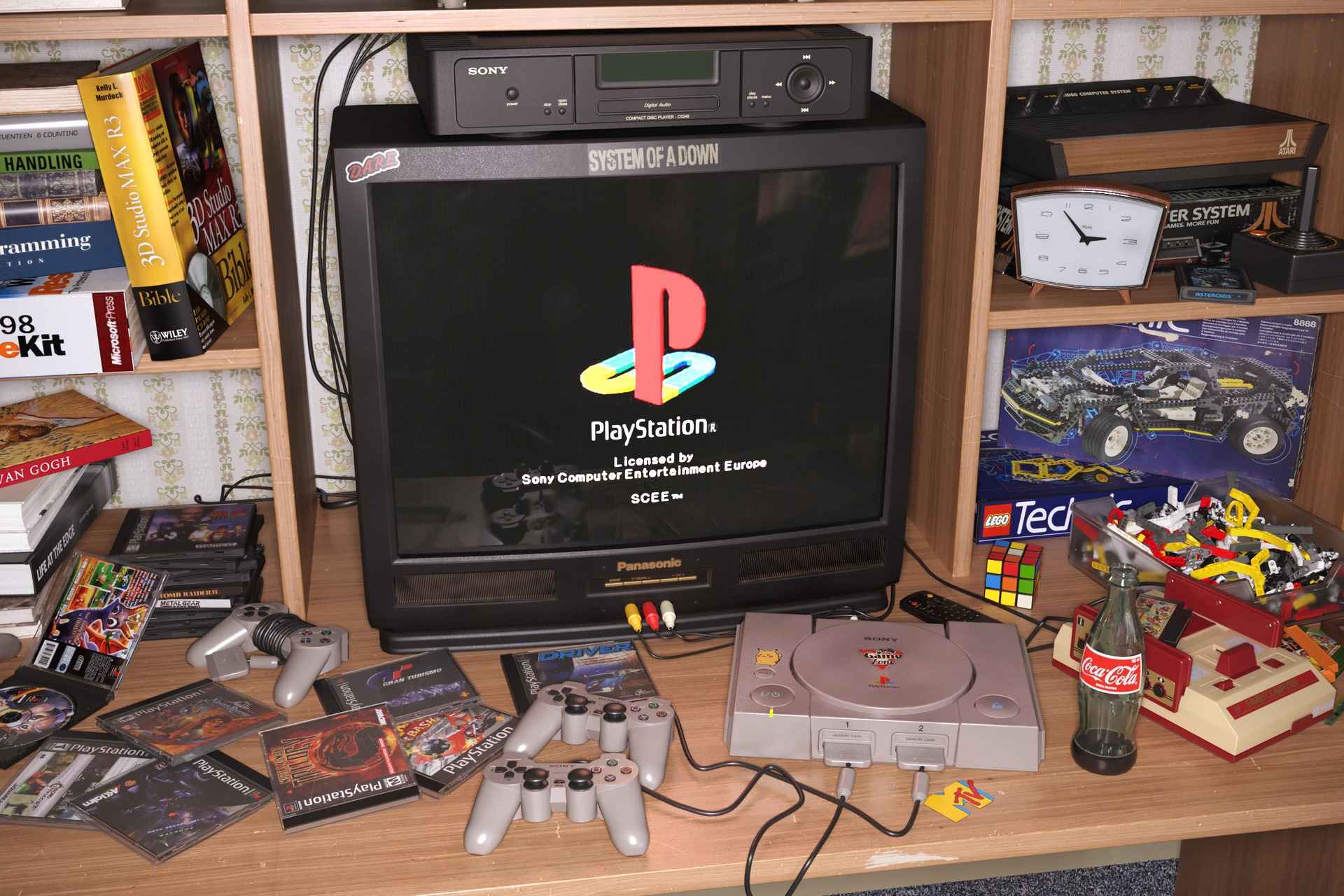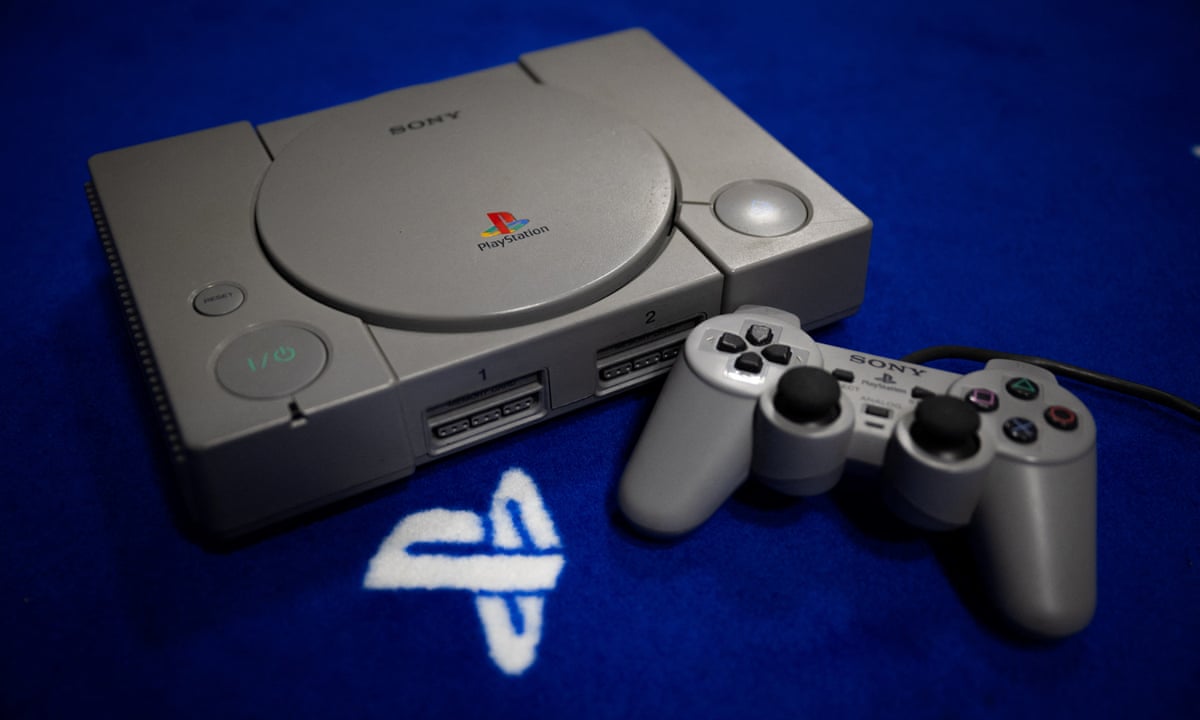
Step into a time machine with us. The year is somewhere in the mid-to-late 90s. The air is thick with the scent of pizza rolls and the sound of a dial-up modem screaming in pain. In the corner of your living room, sits a humble grey box. You press the circular power button, the disc inside whirs to life, and two iconic sounds echo through the room. A deep, resonant hum followed by a triumphant, twinkling chime. For an entire generation, this wasn’t just the boot-up sequence of a console; it was the start of an adventure. This is the story of the Sony PlayStation, the accidental hero that didn’t just join the game—it changed it forever.
Born from a corporate betrayal that would become the stuff of legend, the PlayStation wasn’t supposed to exist. But its arrival in 1994 (Japan) and 1995 (North America) was a seismic event. It was a Trojan horse, smuggling video games out of the toy aisle and into the heart of mainstream pop culture. It made gaming cool for teenagers and adults, transforming it from a niche hobby into a global entertainment powerhouse. This isn’t just a misty-eyed look back; this is an exploration of how Sony’s rookie console, laid the foundation for modern gaming as we know it.
From Betrayal to Game-Changer: The Genesis of a Giant

The story of the PlayStation begins with a failed partnership. In the early 1990s, Sony was working with Nintendo to create a CD-ROM add-on for the Super Nintendo. Imagine, for a moment, a world where Final Fantasy VII was a Nintendo exclusive. That world almost happened. But at the eleventh hour, Nintendo publicly backed out of the deal, choosing to partner with Philips instead. This public slight left Sony with a CD-based console prototype and a score to settle. Ken Kutaragi, the visionary engineer who would become known as “The Father of the PlayStation,” convinced Sony’s executives not to scrap the project but to go it alone. This decision, born from corporate drama, would reshape the entertainment landscape.
Sony’s secret weapon was the Compact Disc. While its main rival, the Nintendo 64, clung to expensive cartridges, the PlayStation embraced the CD-ROM. This was a masterstroke for several reasons. CDs could hold a colossal 650 MB of data compared to the N64 cartridge’s typical 12-64 MB. This vast storage capacity allowed developers to create sprawling 3D worlds, include high-quality CD audio, and, most revolutionary of all, integrate full-motion video (FMV) cutscenes that brought cinematic storytelling to gaming in a way never seen before. It was the difference between reading a comic book and watching a movie, and gamers were captivated.
Fun Fact: The project’s internal codename was “PS-X,” which stood for “PlayStation X.” The “X” was a constant reminder of Nintendo’s betrayal and fueled the team’s determination to create a superior machine.
The Grey Box of Dreams: A Design for a New Generation

The PlayStation’s design was a masterclass in minimalist appeal. The sleek, grey console was a stark departure from the toy-like designs of its predecessors. It didn’t look like a child’s plaything; it looked like a serious piece of home entertainment hardware, designed to sit alongside your VCR and CD player. The top-loading CD drive with its simple ‘Open’ button was user-friendly and futuristic. This wasn’t just a console; it was a statement. It signaled that gaming was growing up.
This design philosophy extended to the memory cards. While cartridges had built-in save functions, the PlayStation required a separate memory card. This small, colorful brick of plastic became a gamer’s most prized possession. It held your 60-hour RPG save, your best race times, and your unlocked characters. Losing or corrupting a memory card was a tragedy of Shakespearean proportions, a shared trauma for every PS1 owner.

The Controller That Shaped the Future
If you’ve held a video game controller in the last 25 years, you’ve held a descendant of the PlayStation controller. Its design was both an evolution and a revolution. Designer Teiyu Goto respected the Super Nintendo’s popular layout but wanted to adapt it for navigating the new world of 3D games. This led to the addition of a second pair of shoulder buttons (L2 and R2) and, crucially, grip handles that made the controller more comfortable for longer play sessions.
But the most iconic part of the controller is, without a doubt, the four face buttons.
Fun Fact: The iconic symbols on the PlayStation controller buttons weren’t random. Designer Teiyu Goto assigned specific meanings to them: the triangle represents a viewpoint or one’s head, the square refers to a piece of paper for menus, the circle means ‘yes’ (confirm), and the cross means ‘no’ (cancel). This ‘yes/no’ configuration is common in Japanese culture, which is why the ‘O’ button is often used to confirm and ‘X’ to cancel in Japanese games.
The controller’s design was perfected in 1997 with the release of the Dual Analog and, shortly after, the DualShock. The introduction of two analog sticks for precise 3D movement and rumble feedback for immersive haptics was a game-changer. The first game to require the DualShock, Ape Escape, was a revelation, using the sticks for everything from running to controlling gadgets. The DualShock was so successful that its basic layout has become the industry standard, a testament to its groundbreaking design.
A Library of Legends: More Than Just Games
A console is nothing without its games, and this is where the PlayStation truly trounced the competition. Sony’s use of CDs made games cheaper to produce than cartridges, and their open-door policy for third-party developers resulted in a massive and diverse library of over 1,300 games in the US alone. While the N64 was home to a smaller number of undisputed masterpieces, the PS1 offered something for everyone, establishing new genres and redefining existing ones.
The Rise of Cinematic Storytelling (JRPGs)

The PlayStation became the undisputed king of the Japanese Role-Playing Game (JRPG). The massive storage of the CD format was a perfect match for the genre’s epic, narrative-driven adventures. The watershed moment came in 1997 when Square, a longtime Nintendo partner, released Final Fantasy VII. With its breathtaking pre-rendered backgrounds, dramatic FMV cutscenes, and a story that dealt with mature themes of loss, identity, and environmentalism, FFVII became a global phenomenon. It proved that video games could tell stories as powerful and emotionally resonant as any film. The console also gave us other RPG masterpieces like the politically charged Final Fantasy Tactics, the philosophically dense Xenogears, and the charming fairy tale of Final Fantasy IX.

The Birth of Survival Horror
Before the PlayStation, horror games were a niche category. The PS1, however, became the haunted house where a new genre, survival horror, would be born. Capcom’s Resident Evil coined the term, trapping players in a zombie-infested mansion with limited ammo and tank-like controls that amplified the tension. But it was Konami’s Silent Hill that took the genre to a new, psychological level. Using the console’s limitations to its advantage, the game shrouded its terrifying town in a dense fog, creating an atmosphere of pure, nerve-shredding dread where the unseen was more frightening than any monster. These games, along with titles like Dino Crisis and Parasite Eve, proved that gaming could be a truly terrifying experience.

The 3D Platforming Revolution
While Super Mario 64 set the standard for 3D platforming, the PlayStation developed its own cast of iconic mascots. Naughty Dog’s Crash Bandicoot gave Sony an unofficial mascot to rival Mario and Sonic, offering vibrant graphics and addictive, linear platforming. Insomniac Games delivered Spyro the Dragon, a charming adventure with large, open levels to explore. Later in the console’s life, Ape Escape brilliantly utilized the new DualShock controller, becoming a critical darling and a symbol of Sony’s commitment to innovation.
The Age of Action & Stealth

The PlayStation was home to some of the most influential action-adventure games ever made. Tomb Raider introduced the world to Lara Croft, an iconic hero who became a global pop culture phenomenon. The game’s blend of exploration, puzzle-solving, and 3D action in ancient, lonely tombs was unlike anything before it. Then came 1998, and Hideo Kojima’s Metal Gear Solid. It wasn’t just a game; it was a “Tactical Espionage Action” experience. It seamlessly blended stealth gameplay with long, cinematic cutscenes, creating a masterpiece that felt like an interactive Hollywood blockbuster.
The Real Driving Simulator

Racing games were nothing new, but Polyphony Digital’s Gran Turismo redefined the genre. It wasn’t an arcade racer; it was “The Real Driving Simulator.” Players started with a modest used car and had to earn licenses and win races to afford a garage full of meticulously recreated real-world vehicles. The dedication to realism was astounding, and it became the best-selling PS1 game of all time. The commercial success of games like Gran Turismo and Final Fantasy VII was immense, but they were not alone at the top of the sales charts. The list of the PlayStation’s highest-selling titles is a testament to its broad appeal, a hall of fame that truly defined the console’s dominance.
Beyond the Icons: Discovering PS1’s Hidden Gems
While the PlayStation 1 made history with blockbuster hits like Final Fantasy VII, Resident Evil, and Metal Gear Solid, its greatest strength may lie in its sheer breadth of content. Beneath the surface of bestsellers and franchises existed a rich layer of overlooked brilliance—titles that never got the spotlight they deserved but continue to resonate with those who found them.
From inventive RPGs to quirky sims and genre-defying oddities, the PS1 became a haven for experimental and heartfelt projects that wouldn’t have survived under more rigid platforms.
One such title is Harvest Moon: Back to Nature—a humble farming simulation that delivered emotional storytelling, daily-life immersion, and community interaction long before “cozy games” were a trend.
Read the full article on Harvest Moon: Back to Nature and why it’s a PS1 hidden gem – Click Here
“UR NOT E”: Marketing a Revolution

Sony’s marketing for the PlayStation was as revolutionary as its technology. They didn’t target kids; they targeted teenagers and young adults. Their advertising campaigns were edgy, surreal, and often downright weird. Slogans like “UR NOT E” (You Are Not Ready) and the award-winning “Double Life” commercial positioned gaming not as a toy, but as a lifestyle and a core part of modern culture. They sponsored music festivals and extreme sports events, embedding the PlayStation brand into the fabric of 90s cool. This savvy marketing helped shatter the perception of video games as a children’s pastime and established a massive, loyal fanbase that would follow the brand for generations.
The Legacy That Never Fades
The PlayStation was discontinued in 2006, having sold over 102 million units worldwide, the first home console to ever achieve such a feat. Its influence is immeasurable. It set the standard for console design, controller layout, and the use of optical media. It birthed dozens of iconic franchises that are still beloved today and played a pivotal role in making video games the dominant form of entertainment they are in the 21st century.
For those of us who grew up with it, the grey box will always be more than just a piece of hardware. It was a portal to other worlds, a storyteller, a challenge, and the source of countless memories. It was the sound of that boot-up screen, the click of a memory card, and the thrill of seeing a story unfold in ways we’d never thought possible. The PlayStation wasn’t just amazing; it was a revolution. And we were all lucky enough to be there.
[…] This article is part of our larger PlayStation 1 retrospective. Dive into the console’s full history and legacy in PlayStation 1: The Console That Changed Gaming Forever […]
[…] Want the full complete story of the console that made these hits possible? Click here to Explore the… […]